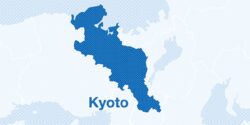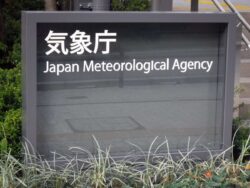Kyoto Pref. Visitor Numbers in 2023 Exceed Pre-Pandemic Level; Prefecture Saw 75.18 Million Visitors in 2023

The foot of Kiyomizudera temple is crowded with tourists in Higashiyama Ward, Kyoto, in August 2023.
17:47 JST, September 15, 2024
KYOTO — The number of visitors to Kyoto Prefecture hit 75.18 million in 2023, up 8.5 million from the previous year, according to the prefectural government. It also exceeded the figure of 74.3 million in 2019 before the COVID-19 pandemic.
Tourism demand for areas other than Kyoto City, including those being promoted by the prefecture, is also on the rise.
Last year, 50.28 million tourists visited Kyoto City, recovering to 94% of 2019 numbers.
Spending by inbound tourists was ¥1.54 trillion in 2023, up by 24.3% compared to 2019, the city said. This created economic ripple effects of about ¥1.7 trillion, up 25.4% from the previous year.
The number of visitors staying at accommodations in the city also increased 12% to 14.75 million in 2023. They included 5.36 million overseas visitors, the highest since the survey began in 1958.
The city said tourism demand fully recovered mainly due to the downgrading of COVID-19 to Category V, the same level as the seasonal flu, under the Infectious Diseases Law.
In 2023, the city surveyed tourists to realize sustainable tourism. The survey found that 67% of Japanese visitors were considerate at their trip destinations by doing things such as bringing their garbage home and having good manners, while as much as 80.2% of foreign visitors did so.
The survey also found 43% of Japanese tourists and 16.3% of foreign tourists said they had experienced something disappointing during their visit to the city, citing congestion and dissatisfaction with public transport, among other things.
The number of visitors to areas outside the city of Kyoto was 24.9 million in 2023, up 4.12 million from 2019. Tourist spending also increased ¥30.2 billion to ¥121.1 billion.
By region, the Otokuni Bamboo Grove area in the Otokuni region, which includes the cities of Nagaokakyo and Muko as well as the town of Oyamazaki, saw 1.26 million visitors, down 110,000 from the previous year. The Kyoto Tea Country area, which contains tea fields in Uji and the surrounding area had 9.32 million visitors, up 1.22 million from the previous year.
Visitors to the Woodland Kyoto area that comprises Kameoka and four other municipalities was 9.38 million, up 960,000 from the previous year. The Kyoto by the Sea area including Maizuru and six other cities and towns had 5.91 million visitors, down 330,000 from the previous year.
Uji was one of the areas that saw a significant increase in visitor numbers from the previous year. The city attracted tourists with its tea-picking experiences, which were suspended during the pandemic, in addition to shrines and temples including Byodoin temple.
The number of visitors to michi-no-eki roadside facilities selling local products and Sanga Stadium by Kyocera in Kameoka also increased.
On Aug. 23, the Kyoto prefectural and city governments announced a tourism promotion plan during a high-level meeting at Kyoto City Hall that will encourage tourists to visit areas other than the city’s well-known tourist spots.
Under the catchphrase, “Marutto Kyoto” (Go Around Kyoto), they began selling model package tours offered by business operators earlier this month, including tours to Yamashina Ward and Fushimi Ward’s Daigo district as well as Ukyo Ward’s Keihoku district and Nantan’s Miyama district.
The prefecture will also consider inviting influencers to the tours so they can promote various regions to attract visitors to wider areas. The idea may be introduced at all municipalities in the prefecture if it proves effective.
"Society" POPULAR ARTICLE
-

M4.9 Earthquake Hits Tokyo, Neighboring Prefectures
-

Israeli Tourists Refused Accommodation at Hotel in Japan’s Nagano Pref., Prompting Protest by Israeli Embassy and Probe by Prefecture
-

M7.5 Earthquake Hits Northern Japan; Tsunami Waves Observed in Hokkaido, Aomori and Iwate Prefectures
-

Tsukiji Market Urges Tourists to Avoid Visiting in Year-End
-

High School in Kyoto Says Students Shoplifted during Recent School Trip to Bali, Indonesia
JN ACCESS RANKING
-

Tokyo Economic Security Forum to Hold Inaugural Meeting Amid Tense Global Environment
-

Keidanren Chairman Yoshinobu Tsutsui Visits Kashiwazaki-Kariwa Nuclear Power Plant; Inspects New Emergency Safety System
-

Imports of Rare Earths from China Facing Delays, May Be Caused by Deterioration of Japan-China Relations
-

University of Tokyo Professor Discusses Japanese Economic Security in Interview Ahead of Forum
-

Japan Pulls out of Vietnam Nuclear Project, Complicating Hanoi’s Power Plans























